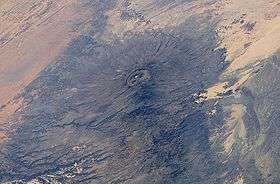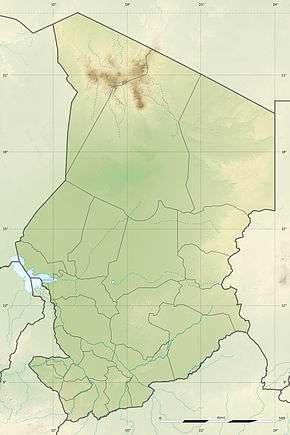Emi Koussi
| Emi Koussi | |
|---|---|
 Emi Koussi seen from International Space Station | |
| Highest point | |
| Elevation | 3,445 m (11,302 ft) [1] |
| Prominence |
2,934 m (9,626 ft) [1] Ranked 103rd |
| Isolation | 2,001 kilometres (1,243 mi) |
| Listing |
Country high point Ultra |
| Coordinates | 19°47′37″N 18°33′7″E / 19.79361°N 18.55194°ECoordinates: 19°47′37″N 18°33′7″E / 19.79361°N 18.55194°E |
| Geography | |
 Emi Koussi Location in Chad | |
| Location | Chad |
| Parent range | Tibesti Mountains |
| Geology | |
| Age of rock | Holocene |
| Mountain type | Pyroclastic shield |
| Last eruption | unknown |
| Climbing | |
| First ascent | 1938 |
| Easiest route | Hike |
Emi Koussi is a high pyroclastic shield volcano that lies at the southeast end of the Tibesti Mountains in the central Sahara of northern Chad. It is the highest mountain in Chad, and the highest in the Sahara. The volcano is one of several in the Tibesti massif, and reaches 3,445 metres (11,302 ft) in elevation, rising 2.3 km (1.4 mi) above the surrounding sandstone plains. The volcano is 60 by 80 km wide.[2]
Two nested calderas cap the volcano, the outer one being about 12 by 15 km in size. Within it on the southeast side is a smaller caldera, about 2–3 km wide and 350 m deep. Numerous lava domes, cinder cones, maars, and lava flows are found both within the calderas and along the outer flanks of the shield.[2] The inner caldera contains large natron deposits which see some harvesting for domestic animal salt lick use by the local people.
Emi Koussi has been studied as an analogue of the Martian volcano Elysium Mons. One of the most important morphological differences between volcanoes on Mars and Earth is the widespread furrowing of the surface due to flowing water on terrestrial volcanoes. The furrows are shallow valleys. Larger channels have a different origin. Major channels can be seen on volcanoes on both planets and indicate low points in caldera rims where lava spilled out of pre-collapse craters.[3]
It was climbed in September 1938 by Wilfred Thesiger and Idris Daud as recorded in the former's autobiography A Life of My Choice.[4]
Gallery
 Emi Koussi as photographed by space shuttle mission STS-108. (The large vertical object in foreground is the vertical stabiliser of the Space Shuttle Endeavour.)
Emi Koussi as photographed by space shuttle mission STS-108. (The large vertical object in foreground is the vertical stabiliser of the Space Shuttle Endeavour.)- As seen from the International Space Station, this photograph highlights the entire volcanic structure
See also
References
- 1 2 "Africa Ultra-Prominences". Peaklist.org. Retrieved 10 February 2013.
- 1 2 "Emi Koussi". Global Volcanism Program. Smithsonian Institution. Retrieved 3 November 2013.
- ↑ "Emi Koussi Volcano, Chad, North Africa". NASA Earth Observatory. December 8, 2002. Retrieved 3 November 2013.
- ↑ Thesiger, Wilfred (1988). A Life of My Choice. Glasgow: Fontana Paperbacks. p. 285. ISBN 0-00-637267-8.
Sources
- Original entry was from the NASA Earth Observatory;
- NASA Earth Explorer page
- Gourgaud, A. & Vincent, P. M. (2004). "Petrology of two continental alkaline intraplate series at Emi Koussi volcano, Tibesti, Chad". Journal of Volcanology and Geothermal Research. 129 (4): 261–290. Bibcode:2004JVGR..129..261G. doi:10.1016/S0377-0273(03)00277-4.
- "Emi Koussi". Global Volcanism Program. Smithsonian Institution.
- "Emi Koussi". Peakware.com.
- "Emi Koussi, Chad" on Peakbagger
External links
| Wikimedia Commons has media related to Emi Koussi. |